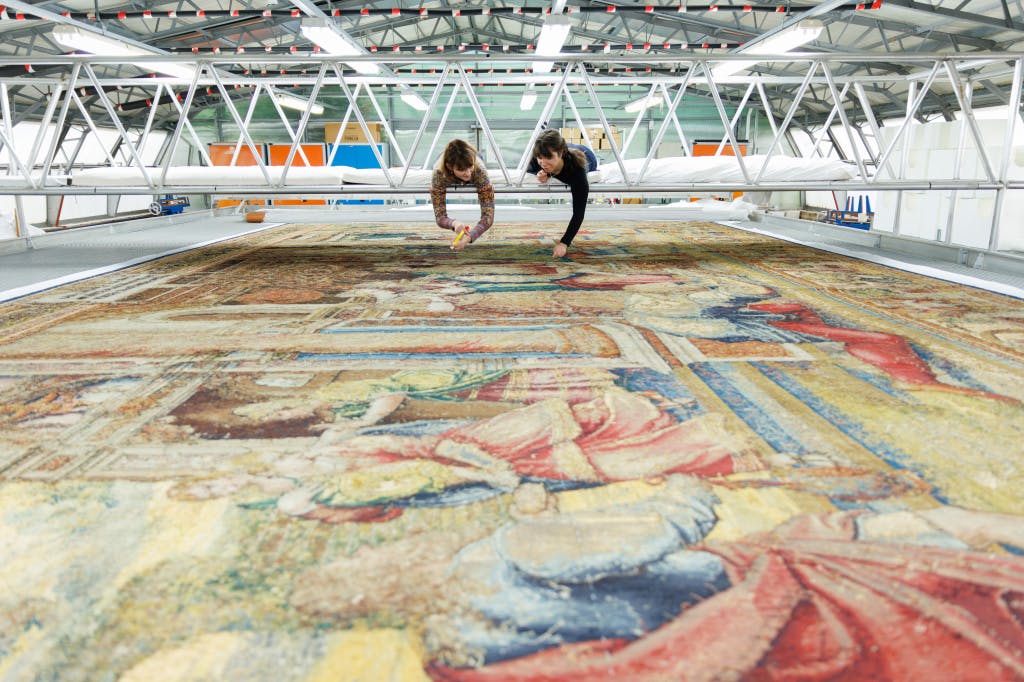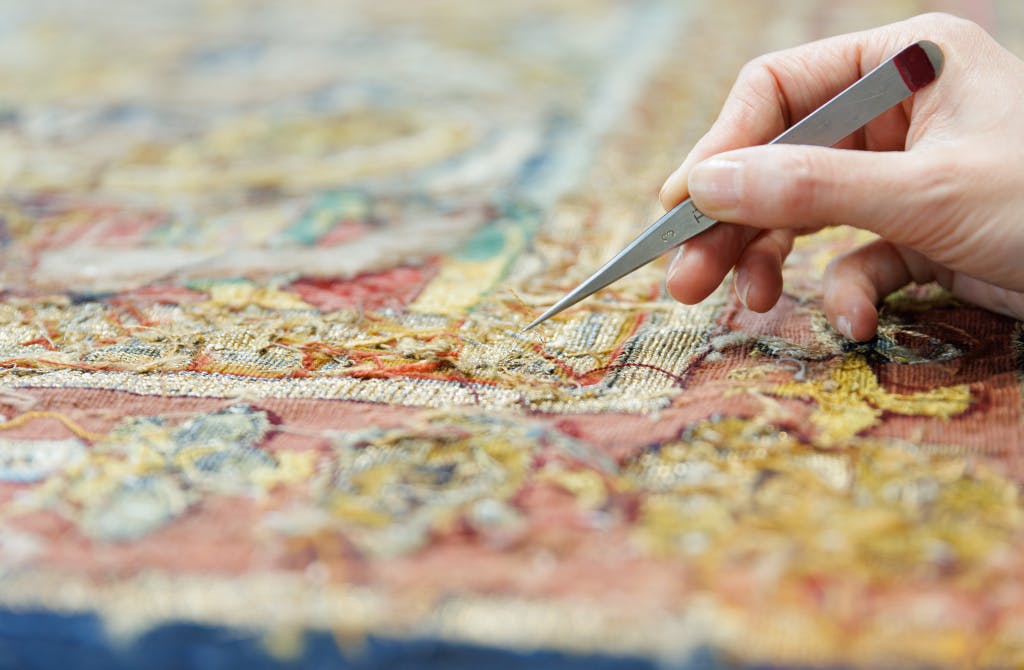Conserving Henry VIII's Abraham Tapestries
Introducing a major new conservation project at Hampton Court Palace
Date: 18 October 2024
Author:
Alice Young
Tudor tapestries are synonymous with Hampton Court Palace, and none more so than Henry VIII’s magnificent Abraham tapestries. These awe-inspiring artworks - part of the Royal Collection - were designed to hang under the glorious hammerbeam roof of the Great Hall almost 500 years ago.
Here, Textile Treatment Conservator Alice Young introduces a new major project at Historic Royal Palaces, to keep the Abraham tapestries looking their best for future generations.
The Abraham tapestries are truly remarkable survivors of that bearded King, Henry VIII’s extensive tapestry collection. They have been referred to as the ‘jewel’ of the Royal Collection and it is easy to understand why.
The Abrahams are truly breathtaking, not only because of their massive scale (eight meters by just under five) but also the skill of the weavers, depicting the life of the biblical prophet Abraham in dazzling detail. Gold, silver, wool, and silk threads have been expertly blended to create a set of 10 tapestries.

Image: The Abraham tapestries in the Great Hall at Hampton Court Palace. © Historic Royal Palaces / Royal Collection Enterprises Limited 2024 | Royal Collection Trust

Image: ’The Circumcision of Isaac. The Expulsion of Hagar’. © Royal Collection Enterprises Limited 2024 | Royal Collection Trust
The Abrahams were woven by Willem de Kempaneer and were acquired by Henry VIII in the 1540s. In the intervening centuries, the tapestries continued to be held in the highest regard; when not on display within Hampton Court Palace, they were sent to Whitehall to be hung at important state occasions.
Fast forward to 1912, and the textile conservation studios at Hampton Court Palace were established by Morris & Co under the watchful eye of English tapestry historian Mr H.C Marillier.
In the intervening years, many of the tapestries underwent full restoration treatments and the Abrahams were no exception. All but one of the Abraham tapestries were restored during the 20th century by highly skilled tapestry restorers. Although their techniques differed significantly from how we conserve tapestries today, it is important to acknowledge the vital role of these restorers in ensuring the tapestries’ long-term survival.

Image: The Abraham Tapestries at The Coronation of James II in Westminster Abbey, 1685 with Circumcision visible on the right-hand side. © Royal Collection Enterprises Limited 2024 | Royal Collection Trust
The tapestries have been on open display for many years, but now we are preparing to conserve them once again. Over the next few years, The Circumcision of Isaac. The Expulsion of Hagar will be conserved in the Tapestry Conservation Studio at Hampton Court Palace.
Circumcision will be the second tapestry in the series of the history of Abraham to undergo a full modern conservation treatment, and excitingly, it will be the first case study to inform the conservation of the other eight tapestries in the set.
The initial stage of Circumcision’s conservation began in 2013 when it was cleaned in Historic Royal Palaces’ bespoke tapestry wet cleaning facility. This process removed many centuries of ingrained dust and soiling that had settled in the tapestry throughout its long-term display. We are now beginning the second stage of its treatment by carefully recording all aspects relating to its condition and material composition. We are taking detailed photographs, notes, and microscopic images to record our findings and processes.
We start by closely examining the front face of the tapestry before rolling it to reveal the entire reverse. The back of most tapestries is obscured by a protective lining so having the chance to examine this is a real treat!
As a textile conservator I can learn so much from the reverse of a tapestry. Original colours are more vibrant, and it’s a real treasure trove of information that will help to inform my approach to the tapestry’s conservation. This allows my colleagues and I to carry out analysis of the metal threads, wool warps, and silk wefts.

Image: The Circumcision of Isaac by his father Abraham as seen from the reverse. © Historic Royal Palaces / Royal Collection Enterprises Limited 2024 | Royal Collection Trust
This is the start of a long-term project where the aim is to conserve all the Abraham tapestries over the course of the next few decades. As such, I always need to be mindful about the legacy that I am leaving behind for conservators in the years to come. My work is only a very small part of these amazing tapestries’ long history and ultimately their future; it is vital that we provide lots of accurate information about our thought processes and clearly justify our approach. All the treatment that textile conservators carry out is designed to last for at the very least 50 years with the specific aim of ensuring long-term stability.
So, join the tapestry team over the next two years as we take you through the milestones of working on this incredibly historically significant tapestry, here on the Historic Royal Palaces Blog.
All being well, the tapestries will hang for another 500 years under the twinkling stained-glass windows of the Great Hall…
Alice Young
Textile Conservator, Historic Royal Palaces
Read more about Henry VIII

Henry VIII, Terrible Tudor?
Who was the real Henry VIII?
Henry VIII’s reign is usually remembered for his six wives and legendary appetite. But it is too easy to think of Henry VIII simply as the terrible monster of his bloated old age, shuffling painfully through Hampton Court Palace.
More from our blog

A model of queenship: Lady Elizabeth's summer with Katherine Parr, 1544
20 September 2024
Tracy Borman travels back to 1544, when Elizabeth spent a happy summer at Hampton Court Palace watching her beloved stepmother, Katherine Parr act as Regent. This visit would have an enduring impact on the young princess.

Using Heritage Science to Conserve Queen Caroline's State Bed
13 September 2024
Work on Queen Caroline’s much-loved State bed, which we care for on behalf of the Royal Collection Trust, continues at Hampton Court Palace and our attentions are now drawn to protecting the feet of this priceless historic object.

Queen Caroline’s State bed is Back!... on Display
09 April 2024
Go behind the scenes with the Conservation team at Hampton Court Palace, who are continuing their work on Queen Caroline's much-loved State Bed.


